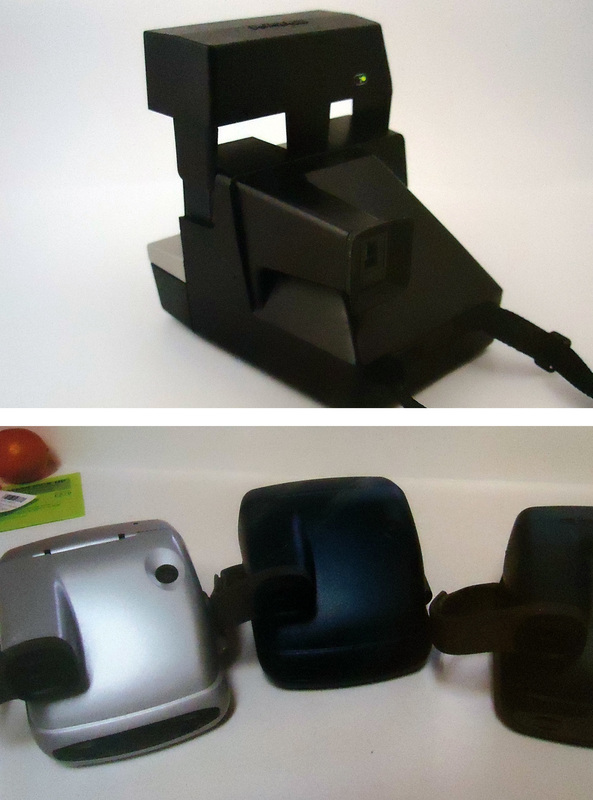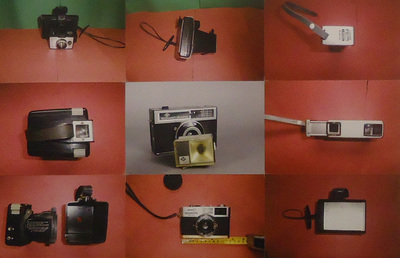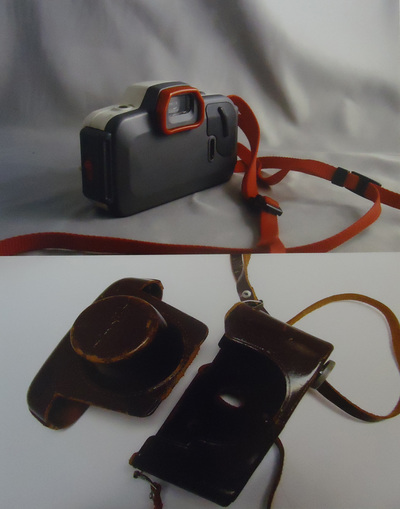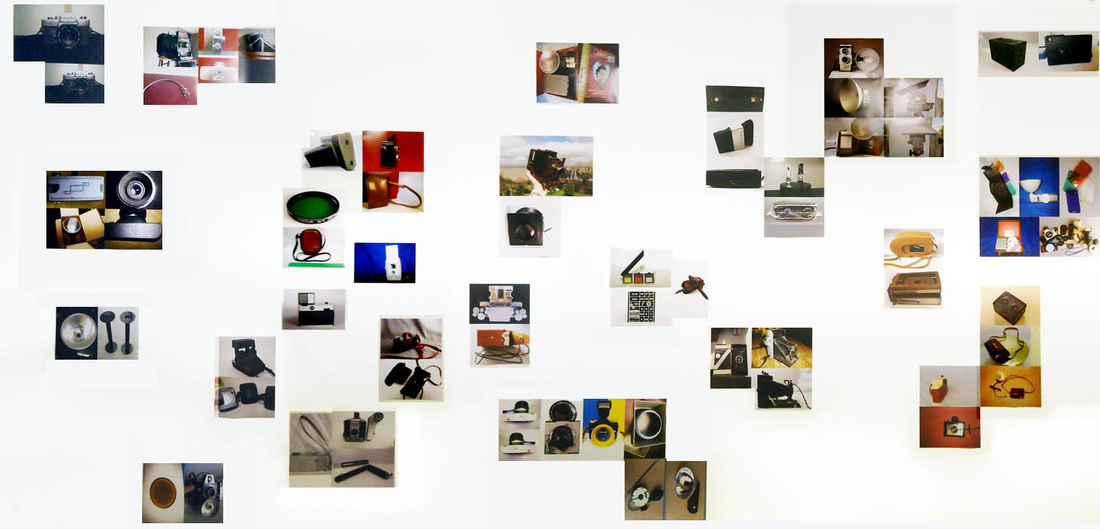Camera Still life - A Memento Mori
C-41 digital prints; various sizes
2013 - present
C-41 digital prints; various sizes
2013 - present
A total of 25 works from Camera Still Life – A Momento Mori were exhibited as part of 'Camera Histories' at Street Level Photoworks.
In Camera Still Life – A Memento Mori, Sylvia has collected and juxtaposed “still life” photographs of cameras for sale. Her interest in online sales images is two-fold: firstly, these cameras are unusual subjects, since the apparatus is associated with the documentation and recording of environments rather than the focus of image-making. Secondly, while cameras and product photography are closely associated, the idea of analog film cameras becoming viable subjects for digital imaging tools is again at odds with typical photographic depiction. The camera lens in front of another demonstrates a direct and fast-paced evolution, and highlights the questions of the place of film cameras in a digital world. It also questions the photographer’s authority of being an image-maker. For this series, the artist has salvaged other photographers’ images to complete her own series.
Digital sellers have objectified discarded cameras as mementos, and in so doing, have evolved new still life compositional rules. Theorist Susan Sontag further alludes to imaging mutability in stating “all photographs are momento mori. To take a photograph is to participate in another person’s (or thing’s) mortality, vulnerability, mutability….” Sylvia thus subtly plays within the perceived relationship between photography as a “living” element and stilled subject. Even while photography as a medium has its own instantaneous capabilities, it can also record transitional change or its own “momento mori”, reflecting the development of the medium. Through image indices of years past, one can examine how the digital camera has replaced the point of perspective and imaging making of its former self.
The memento mori of film cameras as inscribed by its digital imaging has created new image vocabularies for a subject that lacked visual representation. These draw other complicated questions to the foreground: What does it mean for a camera to be a subject for the digital lens today? How are photographic digital images disposable and transitory? What is the impetus to photograph? The artist as conceptual archivist encourages viewers to question their own sensibilities about photo histories, image authorship, and what constitutes contemporary art. Camera Still Life – A Momento Mori ultimately asks us to evaluate and consider the camera and image making in relation to our own aesthetic and digital values.
In Camera Still Life – A Memento Mori, Sylvia has collected and juxtaposed “still life” photographs of cameras for sale. Her interest in online sales images is two-fold: firstly, these cameras are unusual subjects, since the apparatus is associated with the documentation and recording of environments rather than the focus of image-making. Secondly, while cameras and product photography are closely associated, the idea of analog film cameras becoming viable subjects for digital imaging tools is again at odds with typical photographic depiction. The camera lens in front of another demonstrates a direct and fast-paced evolution, and highlights the questions of the place of film cameras in a digital world. It also questions the photographer’s authority of being an image-maker. For this series, the artist has salvaged other photographers’ images to complete her own series.
Digital sellers have objectified discarded cameras as mementos, and in so doing, have evolved new still life compositional rules. Theorist Susan Sontag further alludes to imaging mutability in stating “all photographs are momento mori. To take a photograph is to participate in another person’s (or thing’s) mortality, vulnerability, mutability….” Sylvia thus subtly plays within the perceived relationship between photography as a “living” element and stilled subject. Even while photography as a medium has its own instantaneous capabilities, it can also record transitional change or its own “momento mori”, reflecting the development of the medium. Through image indices of years past, one can examine how the digital camera has replaced the point of perspective and imaging making of its former self.
The memento mori of film cameras as inscribed by its digital imaging has created new image vocabularies for a subject that lacked visual representation. These draw other complicated questions to the foreground: What does it mean for a camera to be a subject for the digital lens today? How are photographic digital images disposable and transitory? What is the impetus to photograph? The artist as conceptual archivist encourages viewers to question their own sensibilities about photo histories, image authorship, and what constitutes contemporary art. Camera Still Life – A Momento Mori ultimately asks us to evaluate and consider the camera and image making in relation to our own aesthetic and digital values.
Camera Still Life – A Momento Mori as displayed at Street Level Photoworks (wall arrangement: approx. 10m wall long by 3.5m tall)

Reviews:
2016
Travis, Rebecca. "The only thing that’s changed is everything" feature article in the 2016 Summer edition of Scottish Society for the History of Photography
https://web.archive.org/web/20180902212635/http://sshop.org.uk/project/rebecca-travis/
2014
Travis, Rebecca. “Sylvia Grace Borda: Camera Histories” in Reviews: Photomonitor, UK. January 27, 2014
http://www.photomonitor.co.uk/2014/01/sylvia-grace-borda-camera-histories/
2016
Travis, Rebecca. "The only thing that’s changed is everything" feature article in the 2016 Summer edition of Scottish Society for the History of Photography
https://web.archive.org/web/20180902212635/http://sshop.org.uk/project/rebecca-travis/
2014
Travis, Rebecca. “Sylvia Grace Borda: Camera Histories” in Reviews: Photomonitor, UK. January 27, 2014
http://www.photomonitor.co.uk/2014/01/sylvia-grace-borda-camera-histories/






